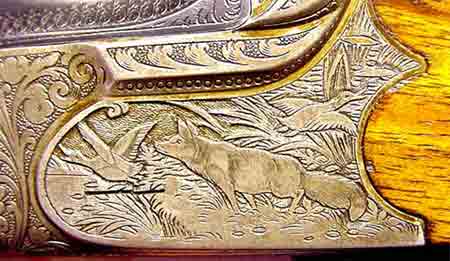|
At the beginning: 
The roots of engravers history in Suhl have been found in the stone age.
The oldest and most reliable lanes have been left by celtic settlers 3000
years ago. They already did ore winning on an mountain called “Suhler
Döllberg”. In the celtic language are expressions like “toll, toill, tul”
in connection with the mining industry. It means that the ore of Suhl
has been already used for celtic arms and tools. The name “Suhlaha” and
“Sulaha” appeared for the first time on a list of the monastery of Fulda.
The first documentary mention of Suhl was in 1318 and since 1527 the town
owns the city right.



|
|
Production as required: 
In 1499 armors, tanks and swords has been produced in Suhl. 16th century:
First big importance of the arm production which was followed by the origin
of the craft of gunsmiths in Suhl. Many gunsmiths called their craft free
art. 17th century: The golden time of arm production in Suhl. There has
been more and more weapons required in Europe for a military use and for
hunting. The growth of production developed the trade of rifles as well.
Around 1600, 200 citizens of Suhl (4000 citizens) have been worked for
the arm production. The gunsmith Simon Stör from Suhl delivered 600 rifle
tubes to Denmark. The good quality supported mass orders for the 30 am
war (i.e. 4000 fuse muskets has been ordered from Stör again.) In 1626
there are 36 gunsmiths with 70 journeymen, 43 trainees and 33 gunsmith
with 20 journeymen located in Suhl. Even the export rate increased in
1631 because more then 28.000 muskets have been delivered from Suhl. 18th
century: In 1708 there are 54 rifle shops run by rifle dealers in Suhl.
The second golden time of arm production was during the 7 am war (1756
– 17629). Another 25.000 arms have been produced for the Prussians.


|
|
Names: 
Suhl, the town of mining industry, weapon and trade developed to an important
craft centre over the last centuries. Some of the well known families
are listed below: Family Sturm, Döll, Hörnlein, Pfeuffer, Schilling, Hoffmann,
Stockmar, Klett, Seeber, Spangenberg, Kolb, Fahner, Hohnbaum, the medialleurs
Steigleder, Stadelmann, Götze, von Nordheim, Freund. Important gunsmiths
are Merkel, Haenel, Sauer, Simson, Meffert, Heym, Krieghoff, Greifelt,
Ziegenhahn. Still existing engravers present their art. (Link to the sale
gallery)


|
![]()
